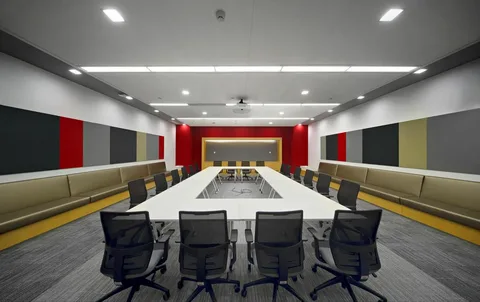In the modern business landscape, the atmosphere and aesthetics of a workplace play a substantial role in shaping its organizational culture and overall functionality. Corporate interior design refers to the practice of creating workspaces that enhance productivity, promote well-being, and embody a company’s brand identity. This discipline encompasses various components, including architectural layout, furniture selection, color schemes, lighting choices, and materials used. By creating environments that inspire collaboration, innovative exhibition stall design, and satisfaction among employees, corporate interior design serves a crucial role in the success of organizations worldwide. (Visit: Corporate Interior Design)
For a deeper insight into the best practices in corporate interior design, visit Woodpeckers Global, and explore opportunities for transformation.
The Significance of Corporate Interior Design
The significance of corporate interior design extends beyond mere aesthetics. A well-designed workspace can improve employees’ morale, boost productivity, and strengthen brand identity. Research indicates that a thoughtful design can enhance collaboration, reduce stress levels, and increase overall job satisfaction—factors that lead to reduced turnover rates and higher engagement levels.
Consider the example of Google, a company synonymous with innovative corporate interior design. Its offices feature open spaces adorned with vibrant colors and stimulating artwork, combined with areas specifically designed for relaxation and play. Workspace variety—from quiet zones to collaborative hubs—promotes creativity and enhances employee well-being. As a result, Google consistently ranks among the best places to work, with high levels of employee satisfaction and productivity.
Key Aspects of Corporate Interior Design
To effectively implement corporate interior design, companies need to consider several key aspects:
- Functionality: The layout of an office should align with the company’s workflow and operations. For instance, an organization that emphasizes collaboration may benefit from an open-plan layout, encouraging spontaneous meetings and communication among employees.
- Branding: Corporate interior design offers an opportunity to reflect a company’s brand identity. Elements such as colors, furniture styles, and art can embody the brand’s values and personality, creating a cohesive environment for clients and staff.
- Biophilic Design: Integrating natural elements into the workspace—such as plants, natural light, and water features—can greatly improve employee well-being. Research shows that biophilic design reduces stress and enhances cognitive function, making for a more productive work environment.
- Flexibility: As workstyles evolve, creating adaptable workspaces becomes essential. Incorporating modular furniture and movable dividers allows companies to reconfigure their workspaces quickly, catering to different team sizes and activities.
Benefits of Corporate Interior Design
Investing in corporate interior design brings forth a variety of benefits that can significantly impact an organization’s bottom line.
- Enhanced Productivity: A well-designed workspace can maximize efficiency. An open layout can foster collaboration, while designated areas for quiet work enable focus.
- Employee Retention: When employees feel comfortable and inspired in their workplaces, their job satisfaction increases. Companies that prioritize interior design often see lower turnover rates.
- Attracting Talent: A visually appealing and functional office space can be an effective recruitment tool. Potential hires are more likely to be attracted to companies that showcase progressive workplace design.
- Improved Health and Well-being: A thoughtfully designed workspace can promote better mental health among employees. Factors like ergonomic furniture and ample natural light contribute to physical comfort and overall happiness at work.
Challenges and Misconceptions
Despite its advantages, several challenges and misconceptions surrounding corporate interior design may discourage organizations from pursuing improvement.
- Cost Concerns: A common misconception is that corporate interior design comes with high expenses. However, investing in design can provide a significant return by enhancing productivity and employee satisfaction. Many firms opt for phased renovations to alleviate budget constraints while still improving their environments over time.
- Complexity of Change: Businesses may fear that redesigning their workspace will be disruptive. By collaborating with professional designers, this transition can be managed efficiently and with minimal disruption.
- Resistance to Change: Employees might be resistant to workplace redesigns, fearing shifts in their daily routines. To mitigate this, involving employees in the design process can create a sense of ownership and anticipation for the changes ahead.
Practical Advice for Implementing Corporate Interior Design
To utilize corporate interior design effectively, consider these practical steps:
- Assess Current Space: Begin by evaluating your current workspace to identify areas that need improvement. Gather employee feedback to understand their needs and preferences.
- Define Your Brand: Use this opportunity to clarify your company’s vision and values. Ensure that your desired design is aligned with your brand identity, incorporating your company colors, mission, and culture.
- Collaborate with Professionals: Engage experienced interior designers who specialize in corporate spaces. Their expertise can guide you in selecting appropriate furniture, materials, and layouts that best suit your needs.
- Prioritize Sustainability: Incorporate sustainable practices in your interior design approach. Consider eco-friendly materials, energy-efficient lighting solutions, and designs that encourage reduced energy consumption.
- Evaluate and Adapt: Once the design is completed, continuously assess its impact on your workforce. Be open to feedback and willing to make adjustments as necessary to meet evolving employee needs.
In conclusion, corporate interior design is an essential aspect of creating a thriving work environment. By investing in thoughtful, functional designs that reflect brand values, organizations can cultivate a collaborative, positive workplace culture that leads to increased productivity and employee satisfaction. Focusing on the well-being and comfort of employees is not merely an aesthetic choice—it is a strategic business decision that pays dividends in the long run.

